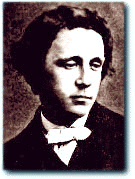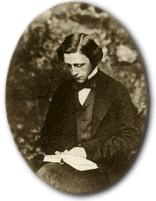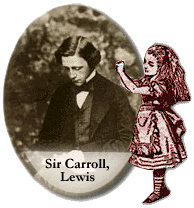| |
Carroll, Lewis, pseudonym of Charles Lutwidge Dodgson (1832-98), English logician, mathematician, photographer, and novelist, best known for his fantasy, Alice in Wonderland.

 Dodgson was the eldest son and third child in a family of seven girls and four boys born to Frances Jane Lutwidge, the wife of the Rev. Charles Dodgson. He was born in Daresbury, Cheshire, on Jan 27, 1832. His father was perpetual curate there from 1827 until 1843, when he became rector of Croft in Yorkshire - a post he held until his death on Jan 14, 1898 in Guildford, Surrey. Dodgson was the eldest son and third child in a family of seven girls and four boys born to Frances Jane Lutwidge, the wife of the Rev. Charles Dodgson. He was born in Daresbury, Cheshire, on Jan 27, 1832. His father was perpetual curate there from 1827 until 1843, when he became rector of Croft in Yorkshire - a post he held until his death on Jan 14, 1898 in Guildford, Surrey.
His family lived in an isolated country village and had few friends outside the family but found little difficulty in entertaining themselves. Charles showed a great aptitude for inventing games to amuse them. The "Rectory Magazines", manuscript compilations to which the family were supposed to contribute, were created when he was 12. In fact, Charles wrote nearly all of those that survive, including Useful and Instructive Poetry (1845; published 1954), The Rectory Magazine (c. 1850, mostly unpublished), The Rectory Umbrella (1850-53), and Mischmasch (1853-62; published with The Rectory Umbrella in 1932).

 Young Dodgson attended Richmond School, Yorkshire (1844-45), and then Rugby School (1846-50). He endured several illnesses during this period, one of which left him deaf in one ear. After Rugby he spent a further year being tutored by his father, during which he matriculated at Christ Church, Oxford (May 23, 1850). He went into residence as an undergraduate there on Jan. 24, 1851. Young Dodgson attended Richmond School, Yorkshire (1844-45), and then Rugby School (1846-50). He endured several illnesses during this period, one of which left him deaf in one ear. After Rugby he spent a further year being tutored by his father, during which he matriculated at Christ Church, Oxford (May 23, 1850). He went into residence as an undergraduate there on Jan. 24, 1851.
Dodgson excelled in his mathematical and divinity studies in 1852; on the strength of his performance in examinations, he was nominated to a studentship (called a scholarship in other colleges). In 1854 he gained a first in mathematical Finals - coming out at the head of the class - and proceeded to a bachelor of arts degree in December of the same year. He was made a "Master of the House" and a senior student (called a fellow in other colleges) the following year and was appointed lecturer in mathematics (equivalent to today's tutor), a post he resigned in 1881. He held his studentship until the end of his life.
As Charles L. Dodgson, the name he used for his academic works, he was the author of a number of books on mathematics, none of enduring importance, although Euclid and His Modern Rivals (1879) is of some historical interest.

Genesis of Alice in Wonderland and its sequel
Alice in Wonderland grew out of Dodgson's entertainment of the children of Henry George Liddell, dean of Christ Church. He had a natural affinity for children, having been the eldest son with eight younger brothers and sisters. He also spoke naturally and easily to children, a relief to him since he suffered from a bad stammer. Alice Liddell and her sisters Lorina and Edith were not, of course, the first of Dodgson's child friends. Dodgson had also enjoyed the company of the children of the writer George Macdonald, the sons of the poet Alfred, Lord Tennyson, and various other chance acquaintances. The Liddell children, however, undoubtedly held an especially high place in his affections.
Alice in Wonderland began as a tale spun by Dodgson, when on July 4, 1862, Dodgson and his friend Robinson Duckworth, fellow of Trinity, rowed  the three Liddell children up the Thames from Oxford to Godstow. They picnicked on the bank, and returned to Christ Church late in the evening. The fairy-tale of Alice's Adventures Underground was told to the children during this occasion. Much of the story was based on a picnic a couple of weeks earlier when they had all been caught in the rain; for some reason, this inspired Dodgson to tell so much better a story than usual that both Duckworth and Alice noticed the difference, and Alice went so far as to plead Dodgson to write down the story. the three Liddell children up the Thames from Oxford to Godstow. They picnicked on the bank, and returned to Christ Church late in the evening. The fairy-tale of Alice's Adventures Underground was told to the children during this occasion. Much of the story was based on a picnic a couple of weeks earlier when they had all been caught in the rain; for some reason, this inspired Dodgson to tell so much better a story than usual that both Duckworth and Alice noticed the difference, and Alice went so far as to plead Dodgson to write down the story.
Dodgson was able to write down the story and added to it several extra adventures that had been told on other occasions. He illustrated it with his own crude but distinctive drawings and gave the finished product to Alice Liddell, with no thought of hearing of it again. However the novelist Henry Kingsley, while visiting the deanery, chanced to have read it, and urged Mrs. Liddell to persuade the author to publish it. Dodgson, honestly surprised, consulted his friend George Macdonald, author of some of the best children's stories of the period, and the latter gave his approval.
 Dodgson revised it for publication by cutting out the references to the previous picnic and added some additional stories to make up a volume of the desired length. At Duckworth's suggestion he got an introduction to John Tenniel, the Punch magazine cartoonist, whom he commissioned to make illustrations to his specifications. The book was published as Alice's Adventures in Wonderland in 1865. However, the first edition was withdrawn because of bad printing, and only about 21 copies survived - one of the rare books of the 19th century. The reprint was ready for publication by Christmas of the same year, though dated 1866. Dodgson revised it for publication by cutting out the references to the previous picnic and added some additional stories to make up a volume of the desired length. At Duckworth's suggestion he got an introduction to John Tenniel, the Punch magazine cartoonist, whom he commissioned to make illustrations to his specifications. The book was published as Alice's Adventures in Wonderland in 1865. However, the first edition was withdrawn because of bad printing, and only about 21 copies survived - one of the rare books of the 19th century. The reprint was ready for publication by Christmas of the same year, though dated 1866.
The book was a success, and by the following year Dodgson was already considering a sequel to it. The result was Through the Looking-Glass and What Alice Found There (dated 1872; actually published December 1871), a work as good as, or better than, its predecessor. Indeed, by his death, Alice (taking the two volumes together) had become the most popular children's book in England. By his centenary in 1932 it was one of the most popular and perhaps the most famous children's book in the world.
Other Works
However, before the two Alices, Dodgson had, in fact, published a number of humorous items in verse and prose and a few inferior serious poems. The earliest appeared anonymously, but in March 1856 a poem called "Solitude" was published using the pseudonym Lewis Carroll. This pseudonym was derived by taking his own names Charles Lutwidge, translating them into Latin as "Carolus Ludovicus", then reversing and retranslating them into English. This name was used later for all his works as an author and poet.
Later in life, Dodgson attempted a return to the Alice vein but only produced Sylvie and Bruno (1889) and its second volume, Sylvie and Bruno Concluded (1893), both regarded as failures by critics, though the two novels taken together are a study of the man.
His poems and verses were collected in 1869 as Phantasmagoria and Other Poems and later (with additions) as Rhyme? and Reason? (1883) and Three Sunsets and Other Poems (published posthumously, 1898).

Dodgson is also remembered as a fine photographer of children and of adults as well. Portraits of the actress Ellen Terry, the poet Alfred, Lord Tennyson, the poet-painter Dante Gabriel Rossetti, and many others have survived and have been often reproduced. In fact, Ellen Terry was one of many child friends of Dodgson. However, in 1880 Dodgson abandoned his hobby altogether, feeling that it was taking up too much time that might be better spent.
http://library.thinkquest.org/10977/carroll/ |
|

 Dodgson was the eldest son and third child in a family of seven girls and four boys born to Frances Jane Lutwidge, the wife of the Rev. Charles Dodgson. He was born in Daresbury, Cheshire, on Jan 27, 1832. His father was perpetual curate there from 1827 until 1843, when he became rector of Croft in Yorkshire - a post he held until his death on Jan 14, 1898 in Guildford, Surrey.
Dodgson was the eldest son and third child in a family of seven girls and four boys born to Frances Jane Lutwidge, the wife of the Rev. Charles Dodgson. He was born in Daresbury, Cheshire, on Jan 27, 1832. His father was perpetual curate there from 1827 until 1843, when he became rector of Croft in Yorkshire - a post he held until his death on Jan 14, 1898 in Guildford, Surrey.
 Young Dodgson attended Richmond School, Yorkshire (1844-45), and then Rugby School (1846-50). He endured several illnesses during this period, one of which left him deaf in one ear. After Rugby he spent a further year being tutored by his father, during which he matriculated at Christ Church, Oxford (May 23, 1850). He went into residence as an undergraduate there on Jan. 24, 1851.
Young Dodgson attended Richmond School, Yorkshire (1844-45), and then Rugby School (1846-50). He endured several illnesses during this period, one of which left him deaf in one ear. After Rugby he spent a further year being tutored by his father, during which he matriculated at Christ Church, Oxford (May 23, 1850). He went into residence as an undergraduate there on Jan. 24, 1851.
 the three Liddell children up the Thames from Oxford to Godstow. They picnicked on the bank, and returned to Christ Church late in the evening. The fairy-tale of Alice's Adventures Underground was told to the children during this occasion. Much of the story was based on a picnic a couple of weeks earlier when they had all been caught in the rain; for some reason, this inspired Dodgson to tell so much better a story than usual that both Duckworth and Alice noticed the difference, and Alice went so far as to plead Dodgson to write down the story.
the three Liddell children up the Thames from Oxford to Godstow. They picnicked on the bank, and returned to Christ Church late in the evening. The fairy-tale of Alice's Adventures Underground was told to the children during this occasion. Much of the story was based on a picnic a couple of weeks earlier when they had all been caught in the rain; for some reason, this inspired Dodgson to tell so much better a story than usual that both Duckworth and Alice noticed the difference, and Alice went so far as to plead Dodgson to write down the story. Dodgson revised it for publication by cutting out the references to the previous picnic and added some additional stories to make up a volume of the desired length. At Duckworth's suggestion he got an introduction to John Tenniel, the Punch magazine cartoonist, whom he commissioned to make illustrations to his specifications. The book was published as Alice's Adventures in Wonderland in 1865. However, the first edition was withdrawn because of bad printing, and only about 21 copies survived - one of the rare books of the 19th century. The reprint was ready for publication by Christmas of the same year, though dated 1866.
Dodgson revised it for publication by cutting out the references to the previous picnic and added some additional stories to make up a volume of the desired length. At Duckworth's suggestion he got an introduction to John Tenniel, the Punch magazine cartoonist, whom he commissioned to make illustrations to his specifications. The book was published as Alice's Adventures in Wonderland in 1865. However, the first edition was withdrawn because of bad printing, and only about 21 copies survived - one of the rare books of the 19th century. The reprint was ready for publication by Christmas of the same year, though dated 1866.